Medieval History
The Goths of 5th and 6th centuries A.D. We've all heard of them, no doubt. They must surely have been brutal warriors indeed to have troubled Rome so much over centuries, however it was not originally this way and nor were the Goths inherently troublesome, for it was actually the Huns who initiated the great wave of Ostrogothic and Visigothic migrations. These ancient Germans began streaming in massive numbers across the lands of the Ukraine into Europe, settling north of the Danube as they were pushed farther and farther away from continual troubles with the Huns. Eventually the Gothic kingdom in the Ukraine was destroyed, and so the Goths settled down, obviously taking a breather, becoming the new neighbors of a very troubled Roman Empire. At this point in time, Imperial Rome is not doing so hot, as the Vandals from Carthage continually raid Rome from its southern coasts, as the Romans at this point were still not terribly fond of ships-- they always seemed to crash and down. It's a damn good thing these frustrated Germans came to push on Roman borders! That's just what the Romans wanted! However, contrary to some distorted historical opinion, the Goths really were fine in Western Europe for some time, in fact it wasn't until Attila the Hun succeeded to the throne in A.D. 434 that the Goths were finally getting pushed completely out of the Ukraine and forced even further into Europe. Attila the Hun was terrorizing the Balkans north of This newfound frustration and desperation to survive, coupled with an already troubled and overly defensive Rome, and some close borders between the two, sparked troubles between the Goths and Rome.
SACKING OF ROME AND VISIGOTHIC DOMESTICATION: In A.D. 410, the Visigoths, one of the frustrated Gothic tribes pushed away by Attila's rampage in the Balkans, began to show how much trouble they could be by sacking Rome and ravaging the entire city. The angry Visigoths took anything worthwhile and left shortly after. The Romans moved back in, however, in A.D. 455 Rome was sacked for the second time, this time by the Vandals who had been taking pot shots at Rome for years from their base at Carthage on the tip of Africa. With the new troubles of Imperial Rome, this time actually marks the true beginning of the Goths, who soon united under the barbarian king Clovis in western Europe, the first ever barbarian Christian king, which is important to note because a barbarian king was expected to guide all those under him. By being a Christian king, it meant that all barbarians must follow his lead, effectively changing the entire religion of every Goth. The thing is, Christianity had a tendency to make people calmer and less...genocidal...and so the wild ways of the Visigoths began to slow down and consolidate, and as a side note, paved the way a few centuries later for the Goths to become more Germanesque, so to speak, around the time of Charlemagne. But that is not for a while, and right now they are still a vast collection of barbaric tribes.
END OF ATTILA THE HUN'S RAMPAGE: But this was not the end of Attila yet, as records show he was bribed to march across Europe in exchange for marriage to the beautiful Honoria of the Franks, but met stiff Roman resistance. For 15 years he had terrorized the Balkans and pushed the Goths out of their homeland yet he could not make it quite across the Rhine into Austrasia and Neustria, which correspond roughly to the Benelux (Belgium, Netherlands, Luxembourg) in northern France. Attila?s raid across the Rhine into Gaul was halted, though not defeated, by a Roman army which actually consisted of Franks, Burgundians, Visigoths, Sarmatians, Saxons, Bretons, and Alans under a general, Aetius, who had been raised among the Huns and habitually hired Hunnish mercenaries. Yes, the Visigoths are fighting for Rome, this is because of King Clovis and the new Visigothic way of life, and because Imperial Rome made citizenship via military servitude possible for the Visigoths, many more of them were coming to terms with the western Empire's more civilized way of life.
BARBARIAN ROME:
But not all Christians are civilized! After all, Rome was not having a good century, for the western Imperial Rome had managed to tame many of the Visigothic tribes and even include them into the Roman military and fend off Attila the Hun, by this point Rome was already sacked twice in less than 50 years and the Visigoths were swarming Roman areas, all wanting to become part of Rome and wanting more privileges, but were denied. As you probably already guessed, it still gets worse for those poor Romans, as the last western Emperor of Rome named Romulus Augustulus was deposed in A.D. 476 by a clever Ostrogothic solider named Odaocer, who with much support from many of the eastern (Ostro)Goths and Roman senate, deposed Romulus by leading a revolt of of Herulians, Rugians, and Scirians, marking the end of the Roman Empire in the west. This was possible because Romulus had been declared Western Emperor by his father, the rebellious general of the army in Italy, less than a year before, but had been unable to gain allegiance or recognition beyond central Italy, With the backing of the Roman Senate, Odoacer thenceforth ruled Italy autonomously. But even this was short lived, as the troublesome Theodoric later showed himself a clever nuisance, vexing the borders of the eastern Roman Empire to become king of Italy, and where by turning one troublesome nominal vassal against another, he set the stage to invade Italy successfully and ate up the peninsula between A.D. 489, through A.D. 493, effectively becoming king of a humbled Imperial Rome.????
END OF OSTROGOTHS AND END OF BARBARIAN ROME: Decades later, Ostrogothic King Totila, related to Theodoric, set out against the conquest of the western half of the Roman Empire between A.D. 541-552. the Romans in Italy did not fall even though virtually the entire peninsula around them seemed to be conquered over that decade. Appealing to diplomacy since force seemed useless, Totila reminded the Imperial Roman senate that he was rightful king, as Theodoric was pushed out and he was current king of the Ostrogoth's. The senate would hear none of his ambitious whining. His military luck ran out however, for in A.D. 552 with most of the western half of the Roman Empire still ruled by the Ostrogoths, the eastern half of the Roman empire known as the Byzantine Empire felt her sister Italy had dealt with enough Gothic troubles and stepped in with steel toed boots.
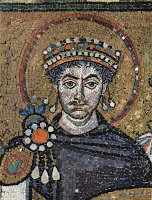
RISE OF THE BYZANTINE EMPPRE: The eastern empire in Byzantium being led by Justinian I under renovatio imperii, or "restoration of the Empire," fought against the Ostrogothic King Totila and his talented rebels, but with the excellent help of skilled commander Narses for Justinian, Ostrogothic King Totila was defeated at the Battle of Taginae by the Byzantines. Followng Justinian I's ambitious renovatio imperii to the letter, Narses immediately moved on to secure the entire western half of the Roman Empire, pushing out the rest of the Gothic troublemakers, effectively reviving the mighty empire by freeing it of its barbarian kings, and uniting both the Eastern and Western halves of the Roman Empire under Justinian I, marking the Beginning of the gigantic Byzantine Empire.
-
Phew, did you catch all that? Looks like western Rome survived after all, but under new management from Justinian. Good God in heaven that was a doozy to write. Could you imagine having all those kings, wars, and radical shifts of government every couple decades? Imagine having a new president, new rules, new officers, and all new faces (foreign rulers no less) every few decades switching everything and warring in gruesome, long battles. I really cannot picture what that is like!
-
Up next is the Rise of Charlemagne in...
"Medieval Europe Part 1: Of Kings and Popes-- Rise of Charlemagne, Fiefdoms, and the Norseme
- Rome's Lost Empire, Bbc One, Review
Iain Hollingshead reviews Rome's Lost Empire, BBC One's one-off documentary in which Dan Snow uses satellite technology to identify the lost cities, amphitheatres and forts of ancient Rome. Just when you thought television had had its fill of...
- The Empire Strikes Back: Rome And Us
Critic at large about new books on Rome. This season brings a number of new works on Roman history that focus not on the glories of Roman culture but on its notorious brutalities. What if the true meaning of Rome is not justice but injustice, not civilization...
- Decline And Fall: New Book Examines How The Western Roman Empire Collapse
The Fall of the Western Roman Empire: An Archaeological and Historical Perspective is the latest book from Dr Neil Christie of the University of Leicester. The division of the vast Roman Empire can be traced chiefly to the 280s AD when the Empire, wracked...
- The Ancient Republic Of Rome Part 3: Iulius Caesar And Pompey The Great
My other blogs are:http://religion-by-kyle.blogspot.comhttp://astronomy-by-kyle.blogspot.com??????The First Triumvirate Gaius Iulius Caesar Gnaeus Pompeius Magnus General Marcus Licinius Crassus The Ancient Republic of Rome Part 3Iulius Caesar, or better...
- The Ancient Republic Of Rome Part 1: A Brief Essay On The Birth Of Rome On Palatine Hill
My other blogs are:http://religion-by-kyle.blogspot.comhttp://astronomy-by-kyle.blogspot.comA Brief Essay on the Birth of Rome on Palatine Hill The Ancient Republic of Rome Part 1Ancient Rome! Who has not learned some of the grand history of Rome? Isn't...
Medieval History
Imperial Rome Part 2: Ostrogoths and Visigoths- The Ancient Germans and an Expanding Rome
My other blogs are:
http://religion-by-kyle.blogspot.com
http://astronomy-by-kyle.blogspot.com
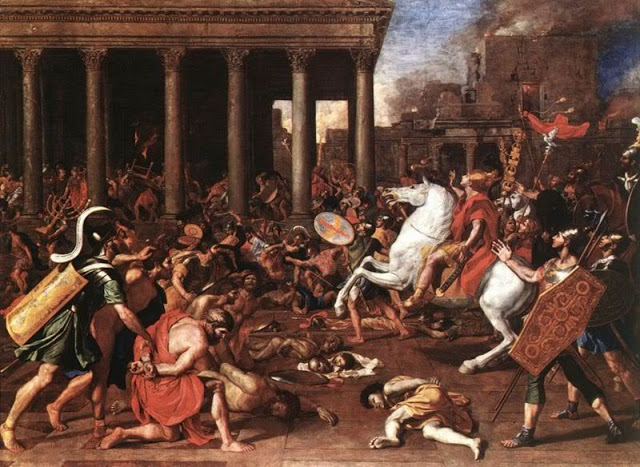 |
| Ostrogoths and Visigoths The Ancient Germans and a Troubled Rome Imperial Rome Part 2 |
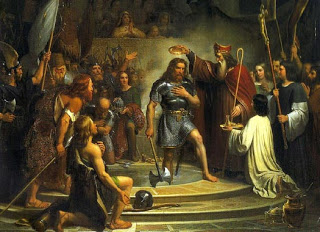 |
| King Clovis A.D. 496, the first ever Christian barbarian king. This is important because barbarians follow the rules and religion of the king, which meant that because of Clovis, all barbarians became Christians, marking the true rise of Christianity where even wild barbarians worship a God of love and forgiveness. Sorry Thor! |
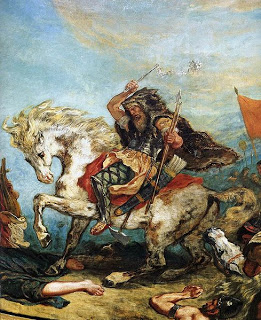 |
| Attila the Hun |
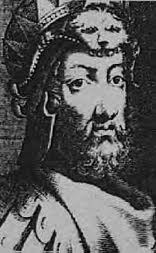 |
| Odaocer |
But not all Christians are civilized! After all, Rome was not having a good century, for the western Imperial Rome had managed to tame many of the Visigothic tribes and even include them into the Roman military and fend off Attila the Hun, by this point Rome was already sacked twice in less than 50 years and the Visigoths were swarming Roman areas, all wanting to become part of Rome and wanting more privileges, but were denied. As you probably already guessed, it still gets worse for those poor Romans, as the last western Emperor of Rome named Romulus Augustulus was deposed in A.D. 476 by a clever Ostrogothic solider named Odaocer, who with much support from many of the eastern (Ostro)Goths and Roman senate, deposed Romulus by leading a revolt of of Herulians, Rugians, and Scirians, marking the end of the Roman Empire in the west. This was possible because Romulus had been declared Western Emperor by his father, the rebellious general of the army in Italy, less than a year before, but had been unable to gain allegiance or recognition beyond central Italy, With the backing of the Roman Senate, Odoacer thenceforth ruled Italy autonomously. But even this was short lived, as the troublesome Theodoric later showed himself a clever nuisance, vexing the borders of the eastern Roman Empire to become king of Italy, and where by turning one troublesome nominal vassal against another, he set the stage to invade Italy successfully and ate up the peninsula between A.D. 489, through A.D. 493, effectively becoming king of a humbled Imperial Rome.????
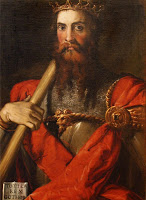 |
| Totila, Ostrogothic King of the East in the Byzantine Empire region |

RISE OF THE BYZANTINE EMPPRE: The eastern empire in Byzantium being led by Justinian I under renovatio imperii, or "restoration of the Empire," fought against the Ostrogothic King Totila and his talented rebels, but with the excellent help of skilled commander Narses for Justinian, Ostrogothic King Totila was defeated at the Battle of Taginae by the Byzantines. Followng Justinian I's ambitious renovatio imperii to the letter, Narses immediately moved on to secure the entire western half of the Roman Empire, pushing out the rest of the Gothic troublemakers, effectively reviving the mighty empire by freeing it of its barbarian kings, and uniting both the Eastern and Western halves of the Roman Empire under Justinian I, marking the Beginning of the gigantic Byzantine Empire.
-
Phew, did you catch all that? Looks like western Rome survived after all, but under new management from Justinian. Good God in heaven that was a doozy to write. Could you imagine having all those kings, wars, and radical shifts of government every couple decades? Imagine having a new president, new rules, new officers, and all new faces (foreign rulers no less) every few decades switching everything and warring in gruesome, long battles. I really cannot picture what that is like!
-
Up next is the Rise of Charlemagne in...
"Medieval Europe Part 1: Of Kings and Popes-- Rise of Charlemagne, Fiefdoms, and the Norseme
- Rome's Lost Empire, Bbc One, Review
Iain Hollingshead reviews Rome's Lost Empire, BBC One's one-off documentary in which Dan Snow uses satellite technology to identify the lost cities, amphitheatres and forts of ancient Rome. Just when you thought television had had its fill of...
- The Empire Strikes Back: Rome And Us
Critic at large about new books on Rome. This season brings a number of new works on Roman history that focus not on the glories of Roman culture but on its notorious brutalities. What if the true meaning of Rome is not justice but injustice, not civilization...
- Decline And Fall: New Book Examines How The Western Roman Empire Collapse
The Fall of the Western Roman Empire: An Archaeological and Historical Perspective is the latest book from Dr Neil Christie of the University of Leicester. The division of the vast Roman Empire can be traced chiefly to the 280s AD when the Empire, wracked...
- The Ancient Republic Of Rome Part 3: Iulius Caesar And Pompey The Great
My other blogs are:http://religion-by-kyle.blogspot.comhttp://astronomy-by-kyle.blogspot.com??????The First Triumvirate Gaius Iulius Caesar Gnaeus Pompeius Magnus General Marcus Licinius Crassus The Ancient Republic of Rome Part 3Iulius Caesar, or better...
- The Ancient Republic Of Rome Part 1: A Brief Essay On The Birth Of Rome On Palatine Hill
My other blogs are:http://religion-by-kyle.blogspot.comhttp://astronomy-by-kyle.blogspot.comA Brief Essay on the Birth of Rome on Palatine Hill The Ancient Republic of Rome Part 1Ancient Rome! Who has not learned some of the grand history of Rome? Isn't...
